In this article, I will compare the delicious and nutritious mulberry fruit with the popular raspberry. Both berries offer unique tastes, nutritional profiles, and health benefits that make them a great addition to your diet. Whether you’re seeking a tart and juicy option or a sweet and vibrant choice, this comparison will help you decide between mulberry fruit and raspberry.
One essential aspect is the taste comparison between mulberry fruit and raspberry. Mulberries have a tart and tangy flavor, while raspberries are known for their sweet and vibrant taste. This difference in flavor can greatly impact your culinary creations and the overall enjoyment of the berries.
Additionally, a nutritional comparison between mulberry fruit and raspberry is crucial. Both berries are packed with essential vitamins, minerals, and antioxidants. Mulberries are a good source of vitamin C and fiber, while raspberries also provide high levels of vitamin C and fiber. Understanding the nutritional composition of these berries will help you make a well-rounded choice for your health.
Both mulberry fruit and raspberry can be used in a variety of ways in the kitchen. From jams and pies to smoothies and salads, these berries add wonderful flavors to a wide range of recipes. Get creative and experiment with mulberry fruit and raspberry to elevate your favorite dishes.
Key Takeaways
- The taste comparison between mulberry fruit and raspberry reveals that mulberries are tart and tangy, while raspberries are sweet and vibrant.
- Both mulberry fruit and raspberry offer a range of health benefits, including high levels of vitamin C, fiber, and antioxidants.
- Choosing between mulberry fruit and raspberry depends on personal preferences, culinary uses, and desired flavor profiles.
- Both berries can be used in various recipes, such as jams, pies, smoothies, and salads, adding delightful flavors to your culinary creations.
- Experimenting with mulberry fruit and raspberry in your favorite recipes can help you discover new taste sensations and unleash your culinary creativity.
Characteristics of Mulberry and Raspberry
Mulberries and raspberries are two distinct berries, each with their own unique characteristics. Understanding the differences between mulberry fruit and raspberry can help you appreciate their individual qualities and choose the right one for your needs.
Mulberry Fruit
Mulberries come in shades of pink, purple, and white, providing a beautiful visual appeal. These berries have an oval shape and are often smaller in size compared to raspberries. When it comes to taste, mulberries have a tart flavor, adding a delightful tanginess to your palate.
Raspberry
Raspberries, on the other hand, offer a vibrant range of colors, including black, purple, red, and yellow. These berries have a conical shape, with a distinctive texture and appearance. Raspberries are known for their sweet and juicy taste, delivering a burst of natural sweetness.
Mulberries originated in China, while raspberries are native to Europe and North Asia. Both berries are grown on trees, but they thrive in different soil types and climatic conditions. It’s important to note these factors when considering the cultivation of mulberry fruit vs raspberry.
Varieties of Mulberry and Raspberry
When it comes to mulberries and raspberries, there is a delightful array of different varieties to explore. These varieties offer unique characteristics in terms of taste, color, and texture, providing a diverse range of options for berry enthusiasts. Let’s take a closer look at some popular varieties of mulberry and raspberry.
Mulberry Varieties
Mulberries come in various types, each with its own distinct qualities. Here are a few notable mulberry varieties:
- Charparral
- Pendula
- Teas
- Bellaire
- Lingan
These mulberry varieties differ in terms of taste, color, and shape. Some may have a sweeter flavor, while others offer a touch of tartness. The color of mulberries can range from deep shades of purple to delicate pinks and even white. With such diversity, there is a mulberry variety to suit every palate.
Raspberry Varieties
Raspberries also have a wide range of enticing varieties to choose from. Here are just a few:
- Amity
- August Red
- Boyne
- Canby
- Caroline
- Comet
- Dinkum
- Dorman Red
- Latham
- Meeker
- Black Hawk
- Hayda
- Lauren
- And more…
Raspberry varieties span a spectrum of colors, including red, black, purple, and even yellow. They also differ in taste, with some varieties offering a sweeter and juicier experience, while others have a tangy or slightly tart profile. With such an extensive range of raspberry varieties, there are endless possibilities for culinary creations.
Nutritional Comparison of Mulberry and Raspberry
When it comes to nutrition, both mulberries and raspberries offer a wide range of essential nutrients that are beneficial for overall health. Let’s take a closer look at the nutritional profiles of these two delicious berries:
| Nutrient | Mulberries | Raspberries |
|---|---|---|
| Calories | 43 kcal | 53 kcal |
| Vitamin C | 36 mg | 26.2 mg |
| Fiber | 1.7 g | 6.5 g |
| Antioxidants | High | High |
Mulberries are a good source of vitamin C and provide a moderate amount of fiber. They contain antioxidants that help protect against oxidative stress and boost the immune system. With a lower calorie content compared to raspberries, mulberries are a great option for those watching their calorie intake.
Raspberries also offer a significant amount of vitamin C and are rich in fiber. Like mulberries, they are packed with antioxidants that can support overall health and well-being. Incorporating raspberries into your diet can provide various health benefits, including cancer prevention, heart health, and improved eye health.
Both mulberries and raspberries are versatile fruits that can be enjoyed as a snack or used in a variety of recipes. With their impressive nutritional profiles, these berries are a delicious way to add a burst of flavor and a dose of health-promoting nutrients to your meals.
Choosing Between Mulberry and Raspberry
When it comes to deciding between mulberry fruit and raspberry, the choice ultimately boils down to your taste preferences and the culinary uses of each berry.
If you enjoy tart and juicy flavors with a slight tanginess, mulberries would be an excellent choice for you. These berries have a unique taste that is slightly tart and mildly sweet. They can add a refreshing twist to your dishes and desserts, making them a great option for those who prefer a bold and vibrant flavor profile.
On the other hand, if you prefer sweet and vibrant flavors that burst with natural sweetness, raspberries are the way to go. Raspberries offer a delightful balance of sweetness and tang, making them a popular choice for a wide variety of culinary creations.
Both mulberry fruit and raspberry can be used in a variety of recipes, including desserts, jams, smoothies, and salads. They bring their unique flavor profiles and vibrant colors to the table, adding a touch of freshness and natural sweetness to your favorite dishes.
When choosing between these delectable fruits, consider the specific flavor profile and texture you desire for your dish. Whether you’re looking for a tangy burst of flavor or a sweet indulgence, mulberry fruit and raspberry are excellent choices to satisfy your taste buds and elevate your culinary creations.
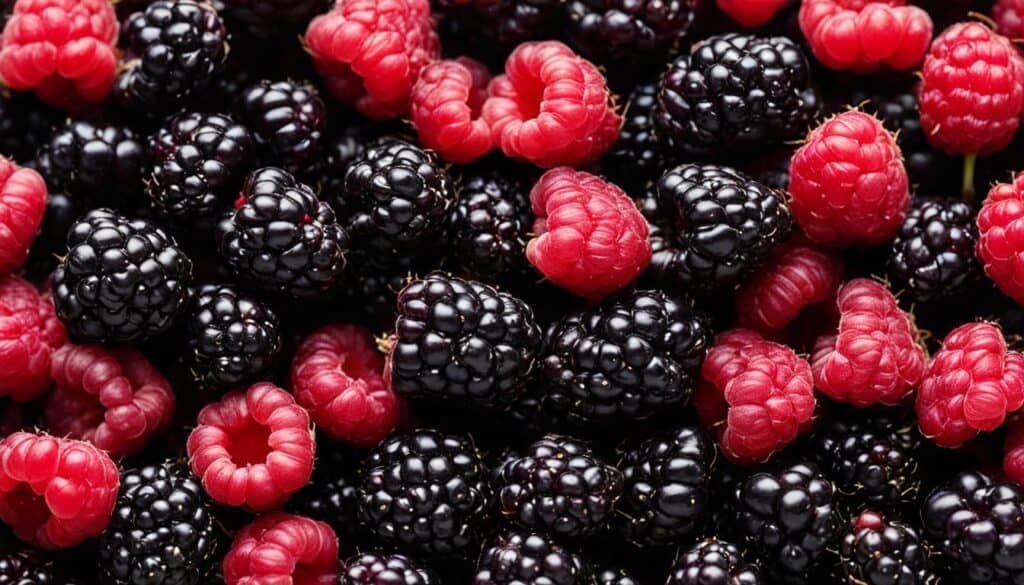
Culinary Inspiration:
“The tartness of mulberries adds a refreshing twist to pies and jams, while the natural sweetness of raspberries shines in tarts and cakes.” – Chef Emily
Cooking Ideas:
- Add mulberries to your morning smoothie for a tangy kick
- Try a raspberry and goat cheese salad for a burst of flavors
- Make a mulberry pie for a delightful dessert
- Create a raspberry sauce to accompany your favorite savory dishes
Flavor Pairings:
| Mulberry | Raspberry |
|---|---|
| Almonds | Dark chocolate |
| Lemon | Mint |
| Vanilla | White chocolate |
Culinary Uses of Mulberry and Raspberry
Mulberries and raspberries are not only delicious but also incredibly versatile fruits that can add a burst of flavor to a wide range of culinary creations. Each berry brings its own unique characteristics to the table, allowing you to explore various taste profiles and experiment with different dishes.
Mulberries:
With their tartness and slightly tangy flavor, mulberries are perfect for making preserves, jams, and pies. The natural sweetness of the berries is enhanced when cooked down, providing a delightful balance of flavors. They can also be added to smoothies and yogurt for an extra punch of taste and nutrition.
Raspberries:
Raspberries, on the other hand, are known for their sweet and vibrant flavor. Their natural sweetness makes them an excellent choice for desserts like tarts, cakes, and crumbles. These berries can be made into delectable sauces and incorporated into salads for a refreshing twist. You can even experiment with adding raspberries to savory dishes like roasted meats to create a unique and unexpected flavor combination.
To give you some inspiration, here’s a recipe suggestion for each berry:
Mulberry Recipe: Mulberry Pie
Ingredients:
- 2 cups fresh mulberries
- 3/4 cup granulated sugar
- 2 tablespoons cornstarch
- 1 tablespoon lemon juice
- 1 teaspoon lemon zest
- 1/4 teaspoon ground cinnamon
- 1 package pre-made pie crust
Instructions:
- In a bowl, combine the mulberries, sugar, cornstarch, lemon juice, lemon zest, and cinnamon. Mix well and set aside.
- Place one pie crust in a pie dish. Pour the mulberry filling into the crust.
- With the remaining pie crust, cut strips and create a lattice pattern on top of the filling.
- Bake at 375°F (190°C) for about 40-45 minutes, or until the crust is golden brown and the filling is bubbly.
- Allow the pie to cool before serving.
Raspberry Recipe: Raspberry Chocolate Tart
Ingredients:
- 1 1/2 cups fresh raspberries
- 1 1/4 cups all-purpose flour
- 1/4 cup unsweetened cocoa powder
- 1/4 cup granulated sugar
- 1/4 teaspoon salt
- 1/2 cup cold unsalted butter, cut into small pieces
- 1/4 cup ice water
- 1/2 cup dark chocolate, melted
Instructions:
- In a food processor, combine the flour, cocoa powder, sugar, and salt. Add the cold butter and pulse until the mixture resembles coarse crumbs.
- Add the ice water, 1 tablespoon at a time, and pulse until the dough comes together.
- Remove the dough from the food processor and shape it into a disk. Wrap it in plastic wrap and refrigerate for at least 1 hour.
- Preheat the oven to 375°F (190°C). Roll out the dough on a floured surface and line a tart pan with it.
- Blind bake the crust by lining it with parchment paper and adding pie weights or dried beans. Bake for 15 minutes.
- Remove the parchment paper and weights, and bake for an additional 8-10 minutes, or until the crust is firm.
- Allow the crust to cool, then spread the melted dark chocolate over the bottom.
- Arrange the fresh raspberries on top of the chocolate in a decorative pattern.
- Chill the tart in the refrigerator for at least 1 hour before serving.
Feel free to get creative and try out different recipes that incorporate mulberries and raspberries. From breakfast to dinner and everything in between, these versatile berries are sure to elevate the flavors of your dishes and impress your taste buds.
Health Benefits of Mulberry and Raspberry
Both mulberry fruit and raspberry offer several health benefits. They are rich in antioxidants, which help protect against chronic diseases and promote overall health. The high vitamin C content in both berries boosts the immune system. Additionally, mulberries have been studied for their potential cholesterol-lowering effects, while raspberries have been associated with improved blood sugar control. Including these berries in your diet can contribute to a balanced and nutritious eating plan.
Antioxidants play a crucial role in neutralizing free radicals, which can damage cells and contribute to the development of chronic diseases like heart disease and cancer. Mulberry fruit and raspberry are packed with antioxidants such as anthocyanins, flavonols, and vitamin C, which help reduce oxidative stress and inflammation in the body.
The vitamin C content in both mulberry fruit and raspberry is beneficial for supporting a healthy immune system. Vitamin C is known to stimulate the production of white blood cells, which are essential for fighting off infections and illnesses. Including these berries in your daily diet can help strengthen your immune response and keep you healthy.
Research has shown that mulberries may have a positive effect on cholesterol levels. Some studies have found that consuming mulberry extract may reduce levels of total cholesterol, LDL cholesterol (the “bad” cholesterol), and triglycerides, while increasing HDL cholesterol (the “good” cholesterol). This indicates that mulberries may have potential cholesterol-lowering benefits and contribute to heart health.
Raspberries, on the other hand, have been associated with improved blood sugar control. Their high fiber content and low glycemic index help regulate blood sugar levels and prevent rapid spikes in blood glucose. This makes raspberries a great choice for individuals with diabetes or those looking to maintain stable blood sugar levels.
Both mulberry fruit and raspberry offer a range of essential nutrients, including vitamins, minerals, and dietary fiber. They can be enjoyed as a part of a balanced diet to support overall health and well-being.
Health Benefits Overview:
- Rich in antioxidants that help protect against chronic diseases
- Boost the immune system with their high vitamin C content
- Potential cholesterol-lowering effects of mulberries
- Improved blood sugar control associated with raspberries
- Contribute to a balanced and nutritious diet
Adding mulberry fruit and raspberry to your daily meals and snacks is a delicious way to enhance your health and enjoy their unique flavors. Whether you’re incorporating them into smoothies, adding them to salads, or simply snacking on them for a burst of natural sweetness, these berries offer a wide range of health benefits that can support your overall well-being.
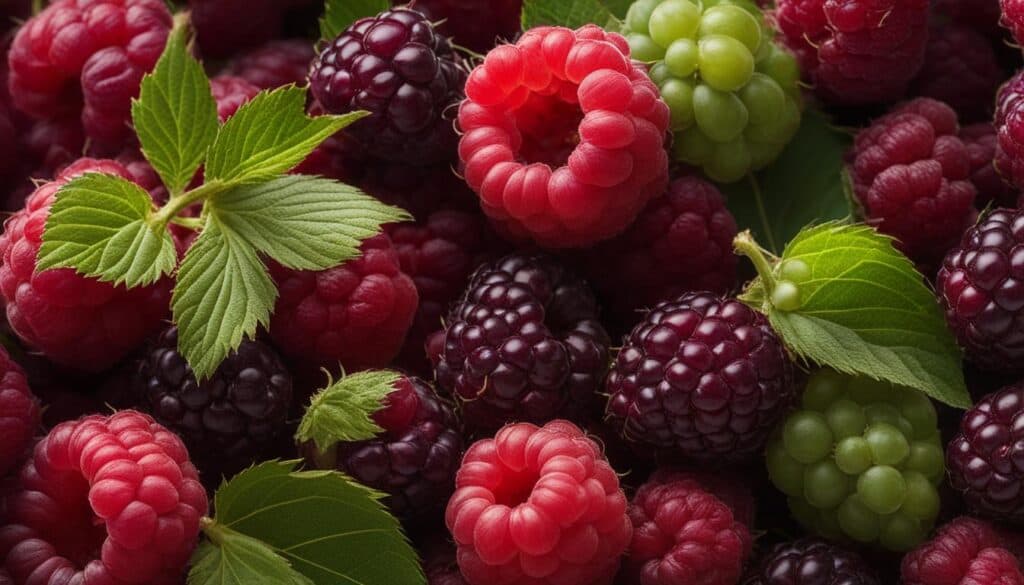
Next, we’ll explore the various ways you can incorporate mulberry fruit and raspberry into your favorite recipes. From desserts to savory dishes, these berries can add a touch of sweetness or tang to elevate your culinary creations.
Recipes with Mulberry Fruit and Raspberry
Mulberry fruit and raspberry can elevate the flavors of various recipes. Try adding mulberries to your morning oatmeal or yogurt for a tart and tangy twist. For a sweet treat, bake a mulberry pie or whip up some mulberry jam. Raspberries can be used in cakes, muffins, and smoothies to add natural sweetness and vibrant color. They are also delicious when paired with chocolate in desserts like tarts and truffles. Get creative and experiment with these berries in your favorite recipes.
| Recipe | Description |
|---|---|
| Mulberry Oatmeal | Add fresh mulberries to your morning oatmeal for a fruity and nutritious twist. Top it off with some honey or yogurt for extra flavor. |
| Mulberry Pie | Bake a delicious mulberry pie with a buttery crust and a sweet and tangy filling. Serve it warm with a scoop of vanilla ice cream. |
| Mulberry Jam | Make your own mulberry jam using fresh mulberries, sugar, and lemon juice. Spread it on toast or use it as a filling for pastries. |
| Raspberry Cake | Indulge in a moist and flavorful raspberry cake filled with fresh raspberries and topped with a creamy frosting. |
| Raspberry Muffins | Bake some delicious raspberry muffins bursting with juicy raspberries. Enjoy them as a quick breakfast or snack. |
| Raspberry Smoothie | Create a refreshing raspberry smoothie by blending fresh raspberries, yogurt, and your choice of milk. Add a sweetener if desired. |
| Raspberry Tart | Prepare a delightful raspberry tart with a buttery crust and a luscious raspberry filling. Serve it chilled for a refreshing dessert. |
| Raspberry Truffles | Indulge in decadent raspberry truffles made with dark chocolate and a raspberry ganache filling. These make a perfect gift or treat for yourself. |
These are just a few examples of the many ways you can incorporate mulberry fruit and raspberry into your recipes. The natural tartness of mulberries and the sweet vibrancy of raspberries add a burst of flavor to both sweet and savory dishes. Whether you’re baking, blending, or cooking, these versatile berries are sure to enhance your culinary creations.
Conclusion
After comparing mulberry fruit and raspberry, it’s clear that both berries offer a delightful combination of flavors and impressive nutritional profiles. Mulberries stand out with their tartness and juicy texture, while raspberries enchant us with their sweetness and vibrant taste.
When deciding between mulberry fruit and raspberry, consider your own palate preferences and culinary aspirations. No matter which berry you choose, you’ll discover a wide range of uses in a multitude of dishes. From mouthwatering desserts to savory delights, both mulberries and raspberries can lend their unique essence to elevate your creations.
Ultimately, selecting between mulberry fruit and raspberry is a matter of personal preference. Whether you crave a zesty burst of tanginess or a lusciously sweet indulgence, these berries provide an exceptional choice that will please your taste buds and nourish your body, leaving you utterly satisfied.
FAQ
What are the differences between mulberry fruit and raspberry?
Mulberries and raspberries differ in terms of color, shape, and taste. Mulberries come in shades of pink, purple, and white, while raspberries can be black, purple, red, or yellow. Mulberries have an oval shape, while raspberries are conical. Mulberries have a tart flavor, while raspberries are sweet.
What are the nutritional differences between mulberry fruit and raspberry?
Both mulberry fruit and raspberry are nutritious and rich in antioxidants. Mulberries are a good source of vitamin C and provide a moderate amount of fiber. Raspberries are also rich in vitamin C and offer a good amount of fiber. Mulberries have a lower calorie content compared to raspberries.
What health benefits do mulberry fruit and raspberry offer?
Mulberry fruit and raspberry offer various health benefits. Both berries are rich in antioxidants, which help protect against oxidative stress and boost the immune system. The high vitamin C content in both berries is beneficial for the immune system. Additionally, mulberries have been studied for their potential cholesterol-lowering effects, while raspberries have been associated with improved blood sugar control.
How do I choose between mulberry fruit and raspberry?
When choosing between mulberry fruit and raspberry, consider your taste preferences and the culinary uses you have in mind. If you enjoy tart and juicy flavors, mulberries would be a great choice. On the other hand, if you prefer sweet and vibrant flavors, raspberries are the way to go.
How can I use mulberry fruit and raspberry in cooking?
Both mulberry fruit and raspberry can be used in a variety of recipes. Mulberries are perfect for making preserves, jams, and pies due to their tartness. They can also be added to smoothies and yogurt for a burst of flavor. Raspberries are great for desserts like tarts, cakes, and crumbles, and they can be incorporated into salads, sauces, and even savory dishes like roasted meats.
What recipes can I make with mulberry fruit and raspberry?
Mulberry fruit and raspberry can be used in a wide range of recipes. Try adding mulberries to your morning oatmeal or yogurt for a tart and tangy twist. For a sweet treat, bake a mulberry pie or make some mulberry jam. Raspberries can be used in cakes, muffins, and smoothies to add sweetness and vibrant color. They are also delicious when paired with chocolate in desserts like tarts and truffles.

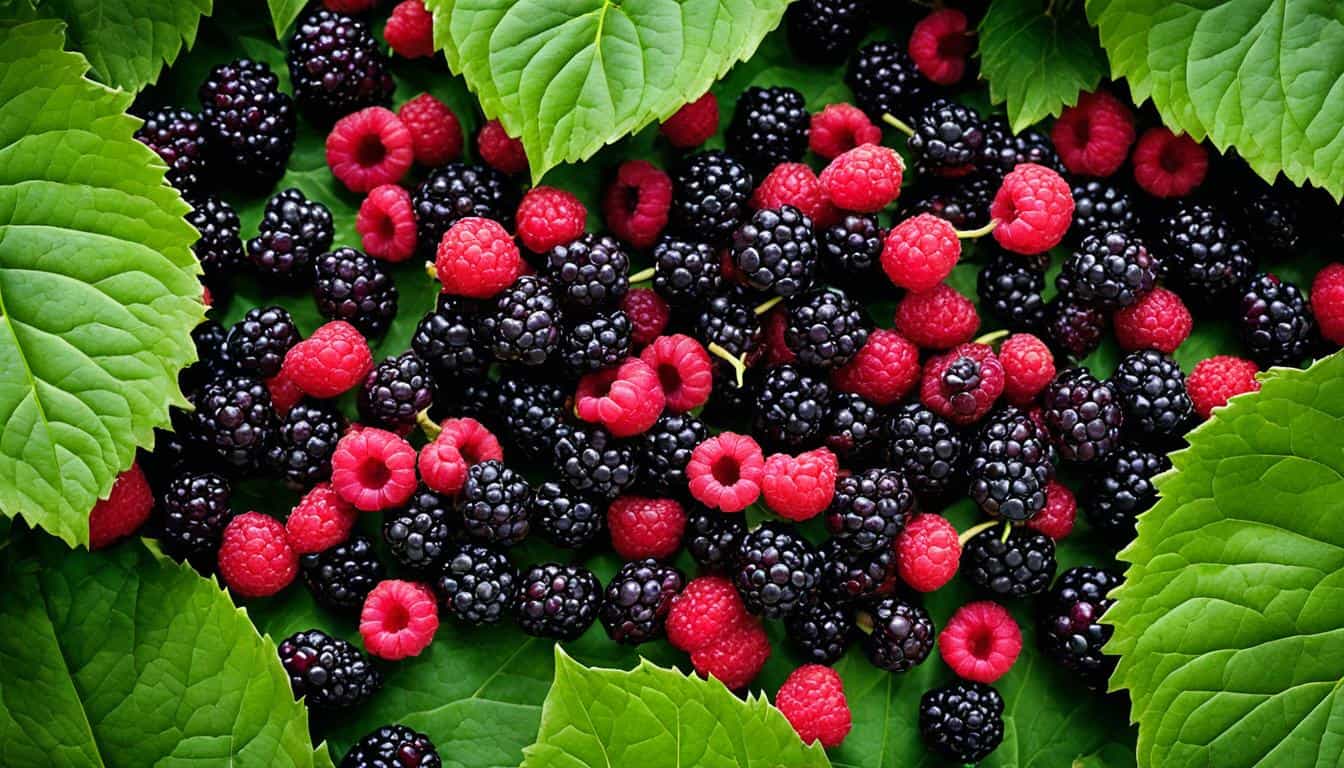
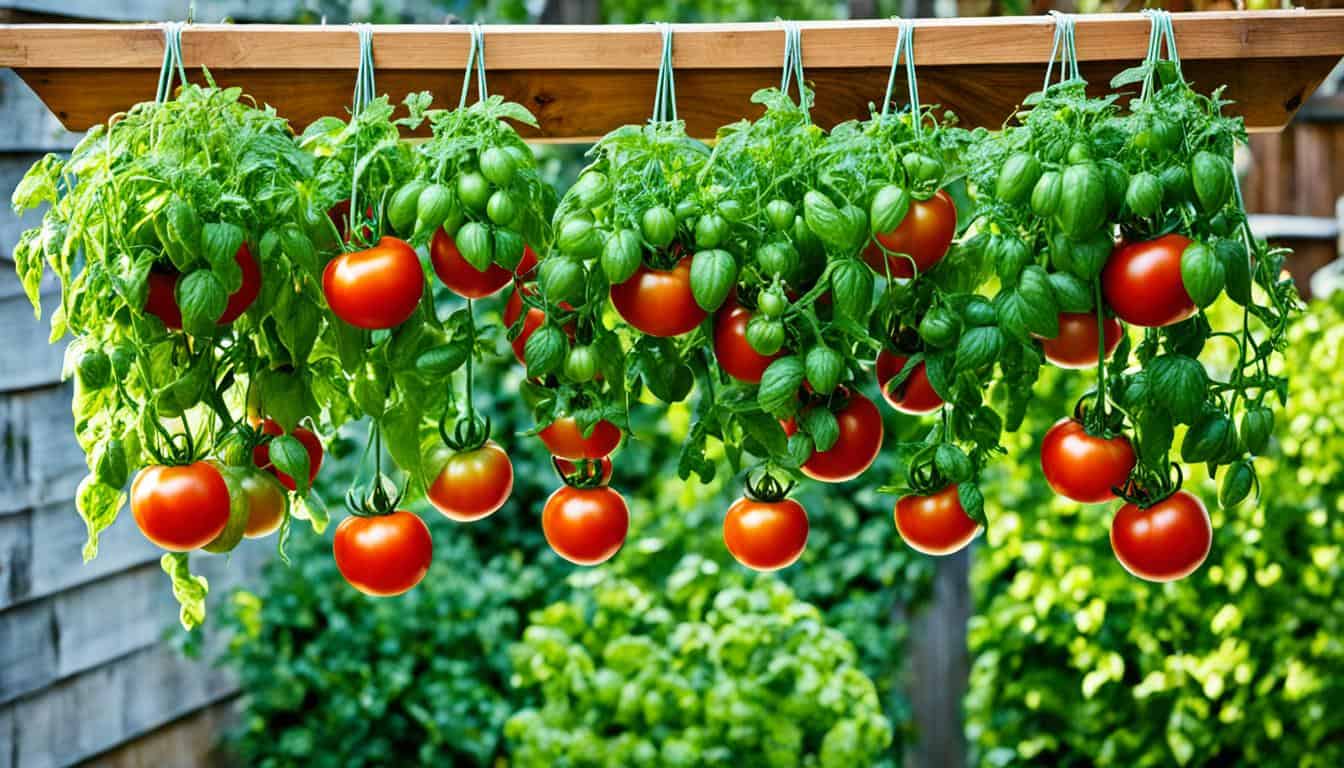
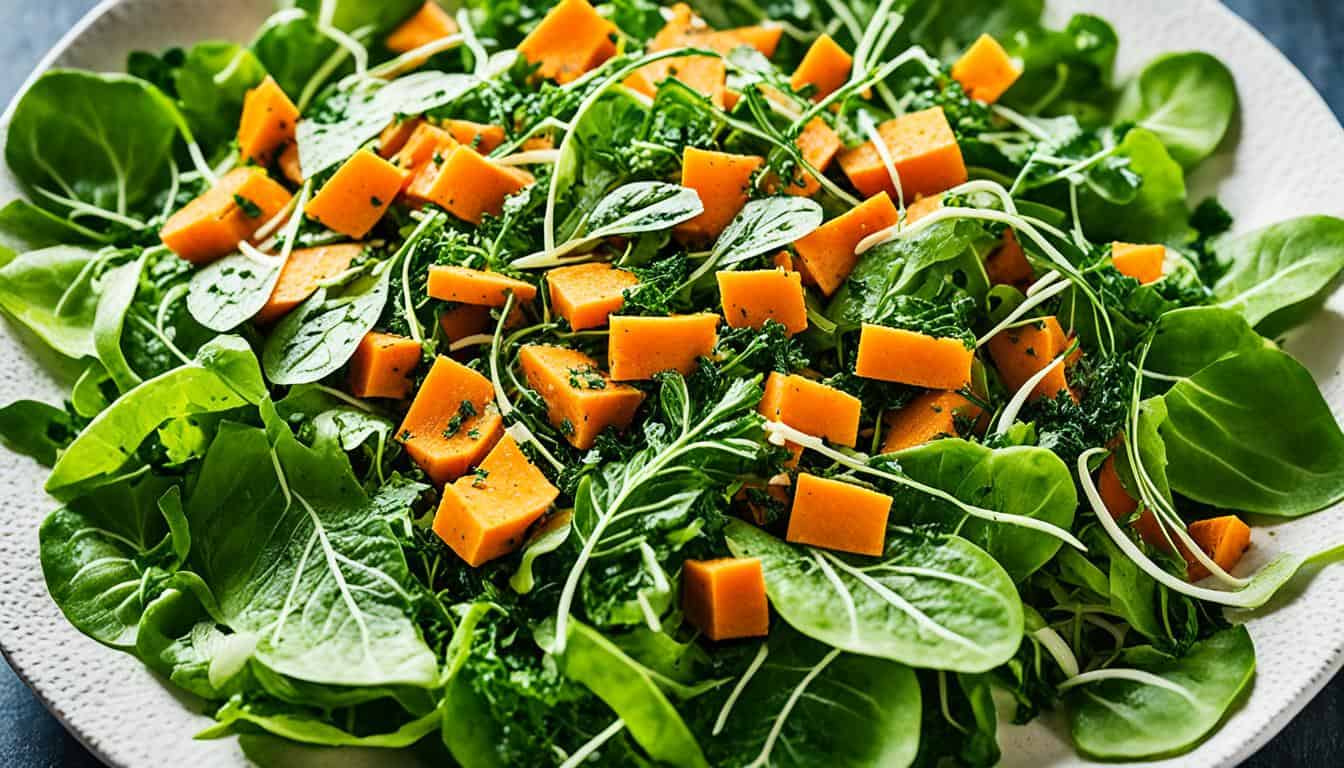
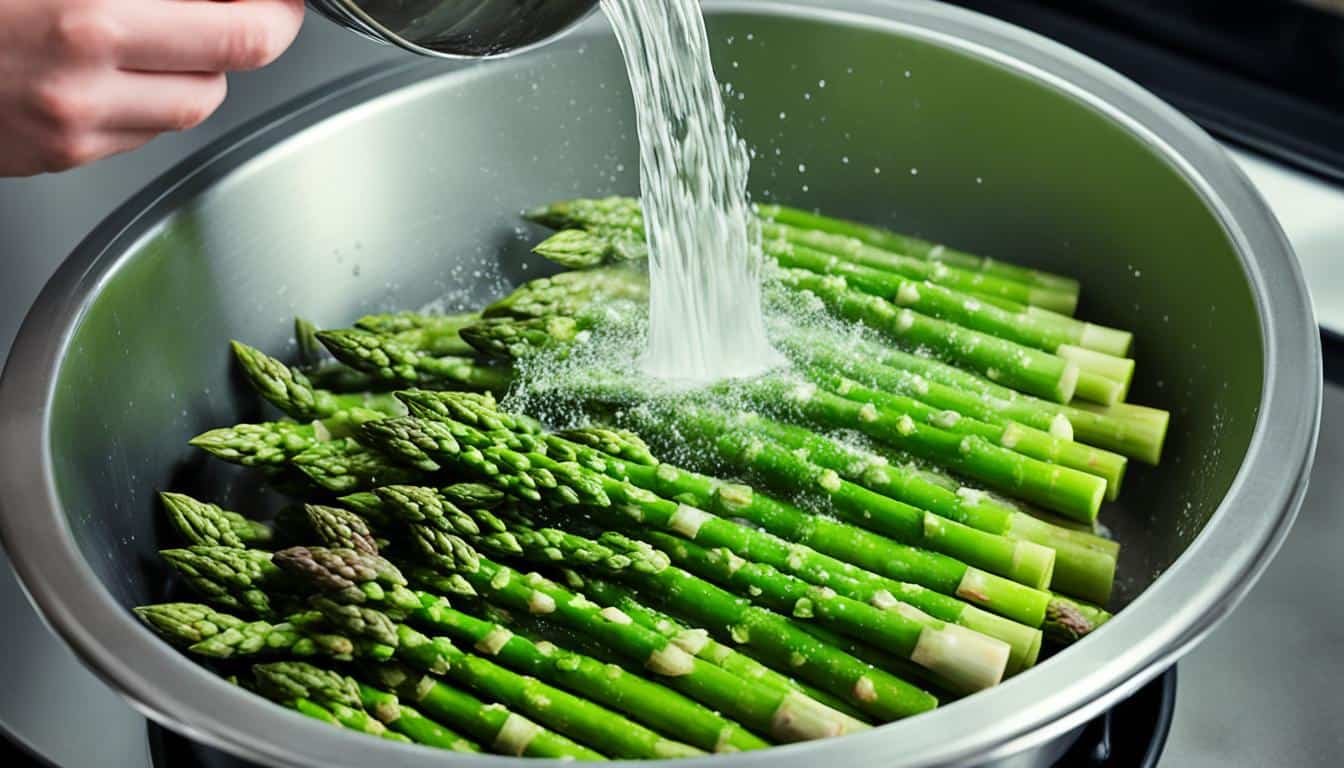
Leave a Reply